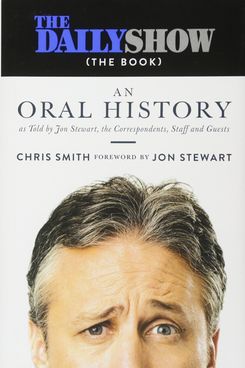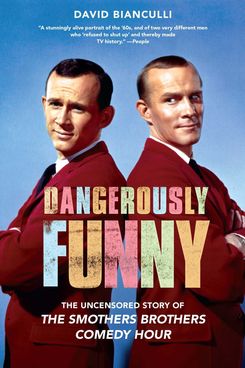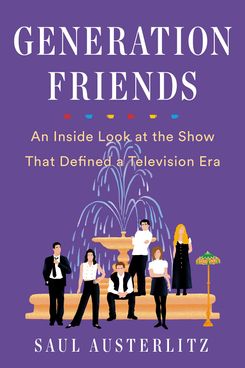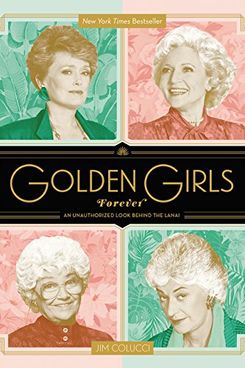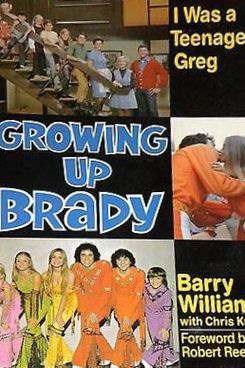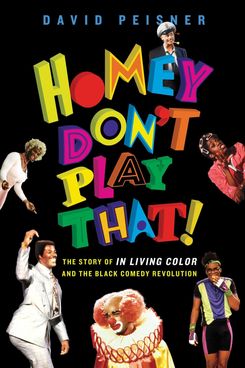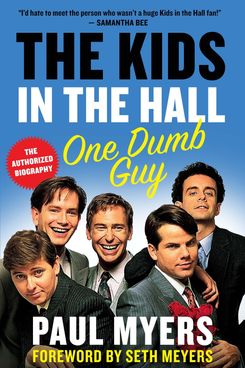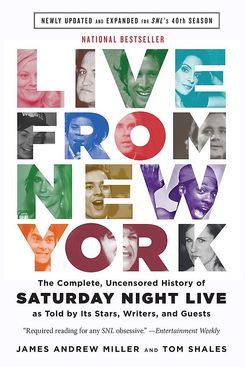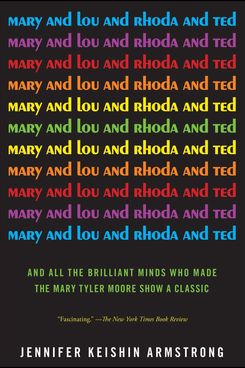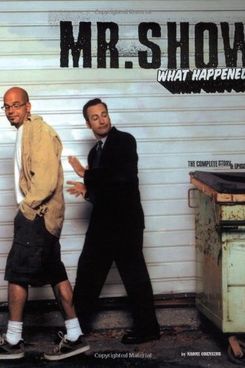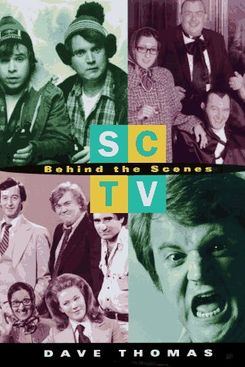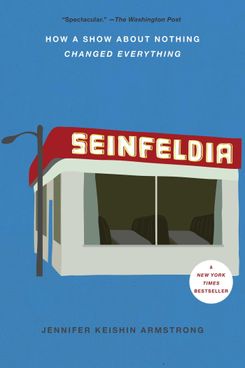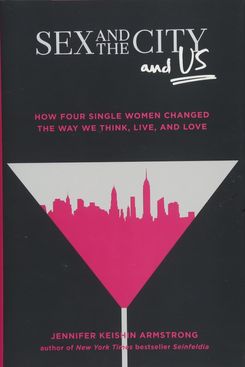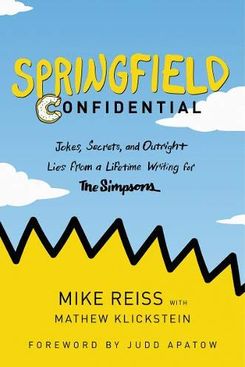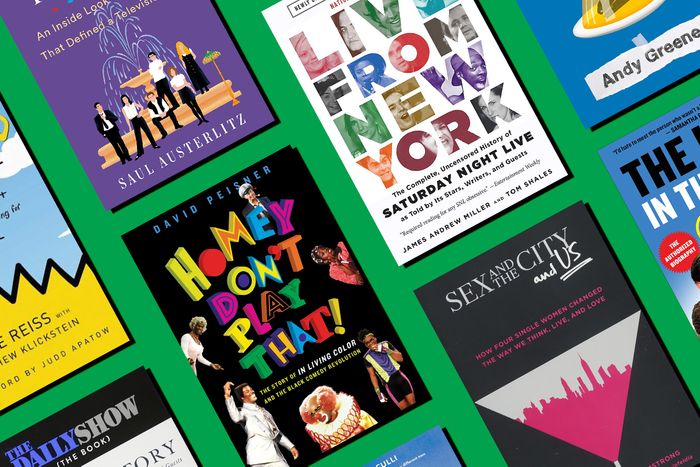
As a comedy-craving hive mind, weÔÇÖve all experienced the sense of longing that arrives right after you finish watching an entire run of a show for the first or 15th time. The seriesÔÇÖ world is familiar and comforting, and you want more of it ÔÇö every little morsel you can find. And so the internet wormholing begins, inhaling the showÔÇÖs IMDb trivia page, its Wikipedia, the videos of journalist-moderated cast reunions, and maybe even a rewatch podcast. When those things are just not enough, there are books about shows ÔÇö the definitive, legitimate, printed, and bound final say.
And there are lots of books about TV, offering a means by which to relive the show and also to experience it in a new way and learn most everything there is to know about its conception, execution, and impact, often with the people who helped make the series in some way. Here then are the 15 best books about TV comedy shows.
Like the Jon Stewart era of The Daily Show itself, this 400-page 2016 book about the rise and development of the 1999ÔÇô2015 late-night institution into an important, constant provider of humorous speaking truth to power packs in a lot of heady information, but it flies by in an entertaining and delightful way. ItÔÇÖs truly staggering how an episode of The Daily Show comes together, and even more staggering that they manage to produce a new installment almost every day. Secondarily, SmithÔÇÖs well-populated oral history details the emergence of Comedy Central as a viable comedy marketplace.
To anyone under the age of, oh, 60, the Smothers Brothers (if theyÔÇÖve made any impression at all) may conjure an image of a couple of dudes playing folk songs with interruptions for their vaudevillian brother act of Smart Brother (Dick) versus Dumb Brother (Tommy). But 2010ÔÇÖs Dangerously Funny shows all us non-boomers how wrong we were about the Smothers Brothers. In the late ÔÇÖ60s they hosted The Smothers Brothers Comedy Hour, a mostly harmless variety show, until they started savagely mocking President Nixon and protesting the Vietnam War. These things were just not done on the conservative airwaves of prime-time television in the ÔÇÖ60s, and the brothers paid the price.
Friends is obviously still popular ÔÇö reruns of the show, dated as they may look with RachelÔÇÖs haircut and JoeyÔÇÖs leather vests, fueled Netflix for years. And yet in his definitive 2019 guide, Austerlitz writes from a point of view as if of Friends-mania were still happening. ItÔÇÖs a thorough and complete history of the 1994ÔÇô2004 TV classic that changed TV comedy. How? Apart from everyone getting that haircut and wearing leather vests, sitcoms werenÔÇÖt really geared toward hip young adults before Friends, and they certainly werenÔÇÖt about nontraditional family units; it simply spoke to Gen-Xers who were both broke and whose love lives were DOA. Generation Friends is compelling when itÔÇÖs about FriendsÔÇÖ monumental impact on pop culture, but most fascinating are its chapters on how the show was not created overnight. It took a lot of time, tries, false starts, and working through bad ideas to get this instantly perfect TV show going.
ItÔÇÖs weird to say that The Golden Girls is a cult classic, considering how it was a top-ten hit and ran for seven years. But in the three decades since it left NBCÔÇÖs Saturday night lineup, itÔÇÖs grown into a millennial obsession. ItÔÇÖs aged better than most ÔÇÖ80s sitcoms, and it was also far more progressive and inclusive; few shows at the time acknowledged that gay people or women over the age of 40 even existed. The Golden Girls was human, heartfelt, and caustic all at once, and all that and more is detailed in this 2016 behind-the-scenes look that pieces together various accounts to explore how the show became a timeless outlier.
In many ways, this 1992 book from Williams, the guy who played Greg Brady, a.k.a. Johnny Bravo, a.k.a. the big man on campus on The Brady Bunch, is the prototypical light and frothy not-quite-A-list celebrity biography, one of the first of many to fill B. Daltons and airport newsstands in the ÔÇÖ90s. But itÔÇÖs also one in which the author never doesnÔÇÖt consider the audience ÔÇö Williams (and co-writer Chris Kreski) knows that what we want are the backstage secrets of The Brady Bunch, and ones that will support the fond memories Gen-Xers have of mainlining that sweet and cheesy show in reruns. Williams obliges, unwittingly showing what day-to-day life on a sitcom set can be like, such as TV dad Robert Reed fighting constantly with show creator Sherwood Schwartz, who didnÔÇÖt care that the writing was pablum. But the anecdotes are so good, like the one about Williams showing up to a taping very high, or about the sexual tension between him and Maureen McCormick, the actress who played his stepsister Marcia.
In Living Color is an unfortunately overlooked entry in the history of TV sketch comedy. Upon its debut in early 1990, it was massively popular and massively important, bringing nonwhite, nonÔÇôNew York voices into a realm that was at the time dominated by recurring-character-oriented SNL. In Living Color had them, too ÔÇö the Head Detective, Homey the Clown, Fire Marshal Bill ÔÇö but they were edgier, stranger, and more incendiary than anything else on prime-time TV, where this show shockingly held court. Peisner celebrates In Living Color in his 2018 overview, but also lays out some hard truths about TV comedy, namely that the showÔÇÖs writers and producers struggled for expression, voice, inclusivity, and control and were constantly at odds with a network that didnÔÇÖt realize it had something wonderful.
Even before he gets to the meat of the book ÔÇö five glorious seasons of The Kids in the Hall on the CBC, HBO, and CBS ÔÇö Myers builds up the legend of the Kids, detailing and mythologizing their epic, head-crushing stage shows around Toronto in the early 1980s. Then itÔÇÖs on to the many interpersonal conflicts and deep brotherhood which, in tandem, led to excellent sketch comedy. There are so many wonderful episodes in this 2018 book, like how the ill-fated Kids movie Brain Candy came out of the show (instead of some tantalizingly unmade movie projects) and how their most famous characters, like Buddy Cole, Chicken Lady, and Man in Towel, were created.
Originally published in 2002 and then reprinted a decade later to include even more history of the most considered and discussed TV comedy in American history, this dictionary-sized volume is probably the best book ever written about how a television series works, and how working in TV comedy gets under a personÔÇÖs skin and never gets out. Every quote (itÔÇÖs entirely quotes, as it follows the oral-history route), from the scores of SNL cast and crew Miller and Shales interviewed, speaks volumes about Lorne Michaels and his inscrutable, singular vision, so Live From New York is also the biography of Michaels, told by a thorough examination of his lifeÔÇÖs work. The book is also about creation, reinvention, and how to work well with others. ItÔÇÖs a must-read for creative types and comedy nerds.
The Mary Tyler Moore Show was arguably the first great, modern sitcom, a pioneering workplace comedy aimed squarely at adults, and not a broad family audience. Urbane, intelligent, and character-driven, it ushered TV comedy out of the hokey, Beverly Hillbillies and My Three Sons model and into a modern and sophisticated era. This 2013 book is a thorough, detailed, and nuanced look at the show, especially how tough it was to actually get on the air and to make consistently excellent for so long.
Mr. Show was a miracle of sketch comedy, and itÔÇÖs even more miraculous that it even got made; it was an under-promoted, transgressive, and provocative punk-rock undertaking that somehow aired on HBO for four seasons. The 2002 book about the show also somehow exists, and itÔÇÖs a scrappy, self-published, straightforward, matter-of-fact, postmortem from the inside by Naomi Odenkirk, professional partner and spouse of Mr. Show co-creator and co-star Bob Odenkirk. Tera-daloo.
At the beginning of its original 2005ÔÇô2013 run, The Office was viewed as a second-rate imitation of its more biting, cutting, depressing, and thus cooler British counterpart of the same name. But under the vision of writers like Greg Daniels, and with layered work by actors like Steve Carell, Jenna Fischer, and the dozens of other Dundie-winning paper shills, The Office evolved into the greatest workplace comedy of all time. Just how it did that is the thesis of GreeneÔÇÖs careful and affectionately researched 2020 history. He interviewed dozens of cast members, writers, and crew members, most of whom revealed fascinating facts and heretofore unknown scandalous set stories.
The Second City comedy theater, a live institution in many North American cities, logically led to a TV sketch-comedy show in the late ÔÇÖ70s. It quickly became just as funny and important ÔÇö if not more so ÔÇö than Saturday Night Live (which it followed in many U.S. markets). Structured like a collection of offerings from a low-rent TV channel, SCTV Network launched the careers of the comedy icons of the ÔÇÖ80s, ÔÇÖ90s, and beyond, including John Candy, Catherine OÔÇÖHara, Eugene Levy, Martin Short, and Rick Moranis. Dave Thomas, one half of the ├£ber-Canadian duo Bob and Doug McKenzie, wrote this book in 1996; itÔÇÖs a firsthand, detailed, and nostalgic look back on the whole business of what it was like to be part of such a monumental comedy uprising.
Seinfeld is the rare example of TV that is both commerce and art, and 2017ÔÇÖs Seinfeldia is all about what can happen at that tension point, as well as the minutiae of a show that was wonderfully all about minutia ÔÇö the real worldÔÇÖs nonsense and the tiny parts of its charactersÔÇÖ existence. Armstrong explains the cultural impact of Seinfeld but also the way the show affected individual lives. Not, like, Jerry Seinfeld or Jason Alexander all that much, but people like Monica Yates Shapiro, the inspiration for Elaine, or Chela Holton, who posed for the Rochelle, Rochelle poster.
Its a book  based on a TV show  based on a book. Candace Bushnell wrote the original and definitive modern dating is tricky book that spawned a still-extant industry of paperbacks with whimsically drawn shoes on the cover. Those books want to be Sex and the City the way so many postSex and the Citytype shows have tried to capture the magic. They couldnt. The show was actually better than its source material, and Armstrong lays out a solid thesis of why it was so Zeitgeist-y in this book released in 2018, a few years before the Sex and the City reboot was confirmed. Armstrong got almost everybody involved with bringing this show to fruition to talk about what it means to them, including creator Darren Star, executive producer Michael Patrick King, Sarah Jessica Parker, and Bushnell, who talks about what its like to have an adaptation of ones life adapted into a TV series and then played for laughs.
ItÔÇÖs the longest-running, most important, and most quotable TV comedy ever, and so lots of Simpsons books are out there, but only one, so far, has been written by a big-time player in not only its creation, but in those middle years when the show found its unique voice and created something wholly original. Springfield Confidential, by writer and producer Mike Reiss, feels contemplative, full of awe, and braggy, in that he canÔÇÖt believe heÔÇÖs telling you these stories and also canÔÇÖt believe The Simpsons has worked for so long. Making this show is clearly a labor of joy but also tough work and constant one-upmanship, and 2018ÔÇÖs Springfield Confidential conveys that writersÔÇÖ room vibe as well as busting myths and creating new lore about The Simpsons.
Every editorial product is independently selected. If you buy something through our links, New York may earn an affiliate commission.


